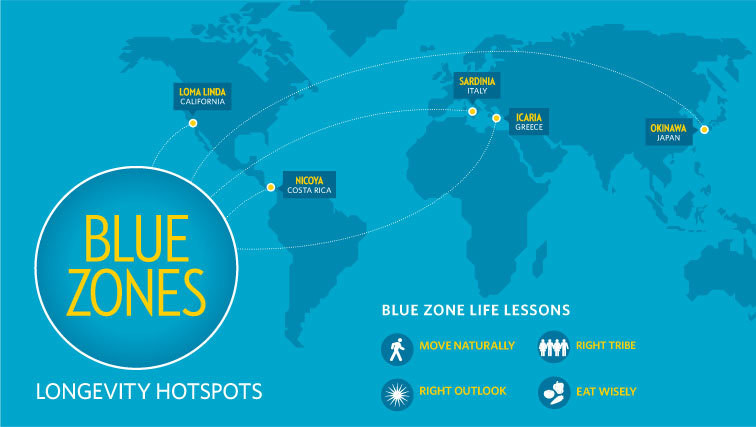


A Look At The Blue Zones: A Longer and Happier Life

The Blue Zones are regions of the world known for their high concentration of centenarians (people who live to be 100 or older) and lower rates of age-related diseases. These regions have attracted attention from researchers and health experts because they offer insights into factors that may contribute to longevity and overall well-being.
Diet in the Blue Zones
One of the most looked-at factors in the longevity of the Blue Zones is their diet. Blue Zones typically have diets characterized by plant-based foods, including plenty of vegetables, fruits, whole grains, legumes, and nuts. They follow a primarily whole-foods diet that is high in carbohydrates. Most of their food is grown locally and made by hand in their own kitchens, fostering a strong sense of community within the villages.
High Carbohydrate, High Health
Despite some misconceptions about carbohydrates, they are essential for our bodies as a source of energy and proper cell function. A high carbohydrate, plant-based diet offers several health benefits when balanced and composed of nutrient-dense foods. Here are some of the advantages:
Heart Health: A plant-based diet rich in complex carbohydrates, such as whole grains, legumes, fruits, and vegetables, is associated with a reduced risk of heart disease. These foods are typically low in saturated fat and cholesterol and high in fiber, which helps lower blood pressure and improve cholesterol levels.
Weight Management: Carbohydrates are an essential source of energy, and a plant-based diet that’s high in complex carbohydrates can help with weight management. Fiber-rich foods like vegetables, fruits, whole grains, and legumes can promote satiety, reducing overall calorie intake.
Digestive Health: High-fiber foods in a plant-based diet promote healthy digestion, prevent constipation, maintain regular bowel movements, and support a diverse and beneficial gut microbiome.
Blood Sugar Control: Complex carbohydrates are digested more slowly than simple sugars, leading to more stable blood sugar levels. The key here is keeping your fat intake low. Eating a lot of carbohydrates in the presence of fats, especially refined fats (oil & processed foods), can have a negative effect on blood sugar levels.
Reduced Risk of Chronic Diseases: A high carbohydrate, plant-based diet is associated with a reduced risk of chronic diseases such as type 2 diabetes, certain types of cancer (e.g., colon cancer), and stroke.
Improved Gut Health: A diet rich in plant-based carbohydrates provides prebiotics, which are beneficial for gut bacteria. A healthy gut microbiome is linked to better overall health, including immune system support and mood regulation.
Lower Risk of Obesity: Plant-based diets are often lower in calorie density, making it easier to control calorie intake and maintain a healthy weight. They can also reduce the risk of obesity-related diseases.
Nutrient Density: A well-balanced plant-based diet provides a wide range of essential vitamins, minerals, and phytonutrients. Fruits, vegetables, whole grains, and legumes are nutrient-rich and promote overall health.
It’s important to note that not all carbohydrates are created equal. While complex carbohydrates from whole foods are generally considered healthy, refined carbohydrates like sugary snacks and white bread should be limited in a healthy plant-based diet.
While the Blue Zones are not technically vegan, as some have small amounts of animal products within them, their diets are often lower in processed foods, added sugars, and red meat. Moderate alcohol consumption, often in the form of red wine, is also common in some Blue Zones.
Exercise in the Blue Zones
Exercise plays a role in the Blue Zones’ lifestyle, but it’s not necessarily structured exercise programs or gym workouts that are common in these regions. Instead, physical activity is woven into the daily lives of the people living in these areas. Here’s how exercise is integrated into the Blue Zones:
Active Daily Routines: In Blue Zones, people tend to engage in regular physical activity as part of their daily routines. They walk or bike to work, tend to their gardens, and perform manual labor, which keeps them physically active without the need for formal exercise programs.
Community-Based Activities: Many Blue Zones communities have traditions of social and community-based activities that involve physical movement. For example, traditional dances, festivals, and celebrations often require people to be physically active and engage with others.
Low-Intensity Activities: While high-intensity exercise is not a prominent feature of Blue Zones lifestyles, low-intensity activities like walking and gardening are common. These activities are sustainable over the long term and contribute to overall physical health.
Natural Movement: Blue Zones residents often engage in natural movements like squatting, lifting, and bending as part of their daily tasks. These movements help maintain strength, flexibility, and mobility.
Connection to Nature: Many Blue Zones are in areas with beautiful natural surroundings, encouraging outdoor activities like hiking and swimming. Being in nature has been shown to have additional mental and emotional health benefits.
Social Connections: In Blue Zones, physical activity is often intertwined with social connections. People walk and interact with friends, family, and neighbors, which fosters a sense of community and social support.
The key takeaway here is that physical activity is an integral part of daily life, and it’s not seen as a separate, structured task. This consistent, low-intensity physical activity has people in their late 90s still riding horses, squatting to sit on the floor, and getting up each day, keeping their bodies physically able to live life. This can inspire us all to not take exercise so seriously and just get out in our gardens or for an evening stroll with our friends more often.
Social and Community Aspects in the Blue Zones
The final aspect that plays an integral role in longevity when it comes to the Blue Zones is their social and community aspects. These regions are renowned for their strong social connections and sense of community, both of which significantly contribute to the health and happiness of the people living there.
Close-Knit Social Networks: Blue Zone communities often foster tight-knit social networks. Residents maintain strong relationships with their families, friends, and neighbors. These connections provide emotional support, a sense of belonging, and a safety net during challenging times.
Inter-generational Relationships: Blue Zone cultures emphasize inter-generational relationships, with multiple generations often living together or in close proximity. This fosters a sense of family unity and allows for the sharing of wisdom and traditions across generations.
Social Cohesion: The sense of belonging to a community is strong in Blue Zones. People often engage in collective activities and traditions, promoting social cohesion. This shared identity and sense of purpose contribute to overall well-being.
Communal Meals: Shared meals are a common practice in Blue Zones. Families and communities gather to eat, converse, and celebrate together. These communal meals strengthen social bonds and provide an opportunity for connection and relaxation.
Active Aging: In Blue Zones, older individuals are actively engaged in the community and contribute to society. They continue to participate in social and communal activities, which provides a sense of purpose and keeps them mentally and physically active.
Sense of Purpose: Blue Zone residents often have a strong sense of purpose in their lives. They feel that they are part of something larger than themselves, whether it’s a family, community, or cultural tradition. This sense of purpose contributes to mental and emotional well-being.
Reduced Stress: The strong social connections and support networks in Blue Zones help reduce stress levels. The feeling of being cared for and having a safety net in times of need can lower stress and contribute to longevity.
Volunteerism and Helping Others: Many Blue Zone residents engage in acts of kindness and service to others. They often volunteer in their communities or assist neighbors in need. This altruistic behavior fosters a sense of interconnectedness and satisfaction.
Celebration of Life Milestones: Blue Zone cultures often celebrate life milestones and events together. These celebrations reinforce social bonds and provide opportunities for joy and connection.
These social and community aspects in Blue Zones contribute to the residents’ overall happiness, well-being, and longevity. Strong social connections, a sense of belonging, and a shared purpose in life are essential components of the Blue Zone lifestyle. These factors not only support longer lifespans but also enhance the quality of life for individuals living in these regions.
Incorporating Blue Zone Principles Into Your Life
By adopting a more plant-based diet, keeping active lifestyles, and maintaining strong social connections within our community, we can mirror the longevity benefits from the Blue Zones. You may not live in Sardinia, Italy or Nicoya, Costa Rica, but every day, the little choices you make within your own home and community foster a healthier and happier life not just for you but also the people around you.
By adopting these lifestyle aspects from the Blue Zones, you can improve your overall quality of life, reduce the risk of chronic diseases, and increase your chances of living a longer, healthier, and more fulfilling life. Remember that these principles can be adapted to your specific circumstances and preferences, making it possible to incorporate them into your daily routine gradually.
I hope this post offers insights into how to make small changes that can drastically improve your quality of life.
Related posts:


